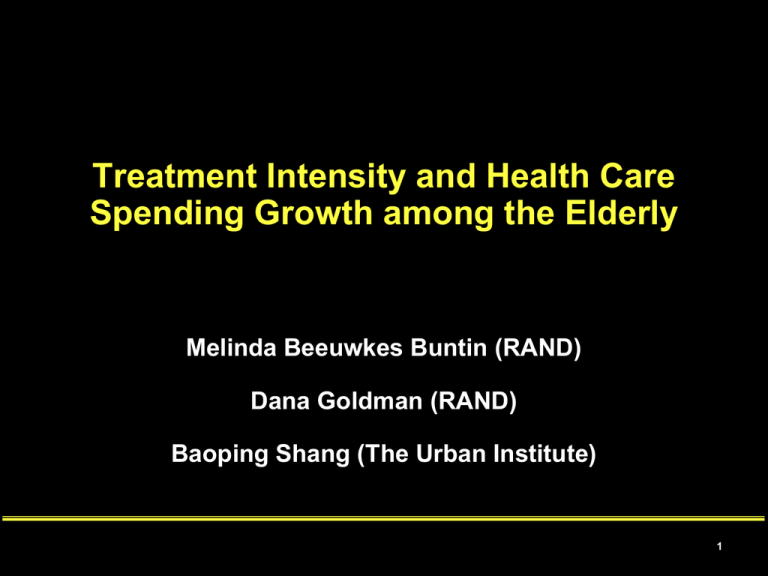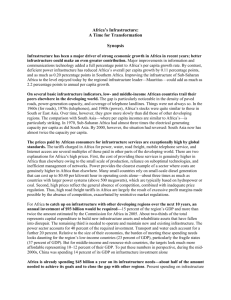Treatment Intensity and Health Care Spending Growth among the Elderly
advertisement

Treatment Intensity and Health Care Spending Growth among the Elderly Melinda Beeuwkes Buntin (RAND) Dana Goldman (RAND) Baoping Shang (The Urban Institute) 1 Background • Rapid growth in overall health care spending and Medicare spending • Factors that might have contributed to health care spending growth − Population aging, health insurance and income − Risk factors such as obesity and smoking, and chronic conditions and disabilities − Technologies − Changes in treatment patterns: • Increase in treated disease prevalence (Thorpe et al. 2005) 2 Research Questions • How treatment intensity has contributed to health care spending growth − More conditions getting treated − Each condition getting treated more intensively 3 Data • Data: The Medicare Current Beneficiary Survey (MCBS) 1993-2003 and associated Medicare claims • Study sample: Medicare (Fee-For-Service) FFS beneficiaries; 65 years of age or older; Community dwelling 4 Measurements • Health care spending: including Medicare spending, beneficiary OOP spending and spending by other health insurance • Treatment intensity: − Number of treated conditions: 0 CCSs; 1-5 CCSs; 5-10 CCSs; 11+ CCSs − Per capita RVUs • Demographics: age, gender, race, education, income, supplemental coverage, et al. • Health status: self-reported disease conditions, functional status and risk factors 5 Methods • Health care spending growth − Regress per capita health care spending on demographics and self-reported health status − Regress per capita health care spending on demographics, selfreported health status and number of treated conditions − Regress per capita health care spending on demographics, selfreported health status, number of treated conditions and per capita RVUs • Decomposition of change in per capita RVUs − New services: CPT codes that were not included in 1993 physician payment schedule − Existing services: • Number of treated beneficiaries receiving services • Number of services per treated beneficiaries • RVU value updates 6 Descriptive Statistics Mean (1993) Mean (2003) Difference Per capita spending (in 2003 $) 6,432 10,142 3,710 Per capita utilization (RVUs) 39.94 72.29 32.35 Age 74.37 75.20 0.83 Male 0.410 0.430 0.019 Self-reported health measures Heart disease 0.382 0.433 0.051 Diabetes 0.168 0.202 0.034 Cancer 0.191 0.187 -0.004 Lung disease 0.140 0.147 0.007 Stroke 0.100 0.122 0.022 HBP 0.539 0.618 0.079 1 or more ADLs 0.293 0.283 -0.009 3 or more ADLs 0.099 0.093 -0.006 Obesity 0.156 0.225 0.069 Ever smoked 0.605 0.603 -0.002 Died 0.036 0.035 -0.001 Number of CCSs 0 CCSs 0.117 0.070 -0.047 1-5 CCSs 0.273 0.131 -0.142 6-10 CCSs 0.281 0.210 -0.071 11 or more CCSs 0.328 0.589 0.261 N 7894 7485 7 Determinants of Health Care Spending Growth • Actual increase in health care spending from 1993-2003: $3,710 • Demographics and self-reported health status: $639 or 17% • Demographics, self-reported health status and number of treated conditions: $2,542 or 69% • Demographics, self-reported health status, number of treated conditions and per capita RVUs: $3,448 or 93% When per capita RVUs are included in the model, the coefficients on demographics, self-reported health and number of treated conditions are reduced to close to zero, indicating that treatment intensity (per capita RVUs) is the direct determinant of health care spending growth. 8 Per Capita RVU growth 75 70 Per Capita Relative Value Unit 65 60 55 50 45 Actual 40 Using 1993 Schedule with value update 35 30 1993 1994 1995 1996 1997 1998 1999 2000 2001 2002 2003 Year 9 Decomposition of Existing Services Year 1993 1994 1995 1996 1997 1998 1999 2000 2001 2002 2003 Total Change Per Capita RVU for Relative to 1993 Existing Codes 39.9 0.0 41.2 1.3 42.1 2.1 44.5 4.5 45.9 6.0 46.6 6.7 49.4 9.5 55.3 15.3 57.6 17.6 61.6 21.6 62.8 22.9 Decomposition of Total Change Percent # of Services RVU Value Treated* Per Treated† Update‡ 0.0 0.0 0.0 2.2 0.8 -1.8 4.0 0.7 -2.5 6.1 1.4 -3.0 7.5 0.0 -1.6 7.4 0.7 -1.5 9.3 0.0 0.2 12.5 2.2 0.6 13.6 3.4 0.6 16.4 4.0 1.2 17.6 4.0 1.3 10 Top 25 Codes Contributing to Per Capita RVU Growth HCPCS % of Total Increase Description 99213 99214 97110 99232 78465 70553 93510 45378 92014 99244 99233 43239 76092 99285 77418 88305 92015 98941 45385 93307 97140 72193 45380 76075 99243 7.63% 6.65% 2.23% 2.18% 2.16% 1.84% 1.73% 1.66% 1.49% 1.38% 1.27% 1.27% 1.25% 1.19% 1.12% 1.08% 1.07% 1.06% 1.00% 0.99% 0.98% 0.91% 0.91% 0.90% 0.86% Office/Outpatient Visit, Established Patients Office/Outpatient Visit, Established Patients Therapeutic Exercises Subsequent Hospital Care Heart Image (3D), M ultiple M agnetic Resonance Imaging of Brain without & with Dye Left Heart Catheterization Diagnostic Colonoscopy Eye Exam & Treatment Office Consultation Subsequent Hospital Care Upper Gastrointestinal Endoscopy, Biopsy M ammogram, Screening Emergency Department Visit Radiation Therapy Delivery, Intensity-M odulated Radiation Therapy Tissue Exam by Pathologist Refraction Chiropractic M anipulation Lesion Removal Colonoscopy Echo Exam of Heart M anual Therapy Computed Tomography Pelvis with Dye Colonoscopy and Biopsy Dual Energy X-ray Absorptiometry, Axial Skeleton Study Office Consultation 11 Conclusion • Demographics and health status only contribute to 17% of the health care spending growth between 1993 and 2003 • Treatment intensity is the primary and direct driver of health care spending growth • − New services − Existing services A limited number of treatments account for a large portion of the increase in treatment intensity 12




